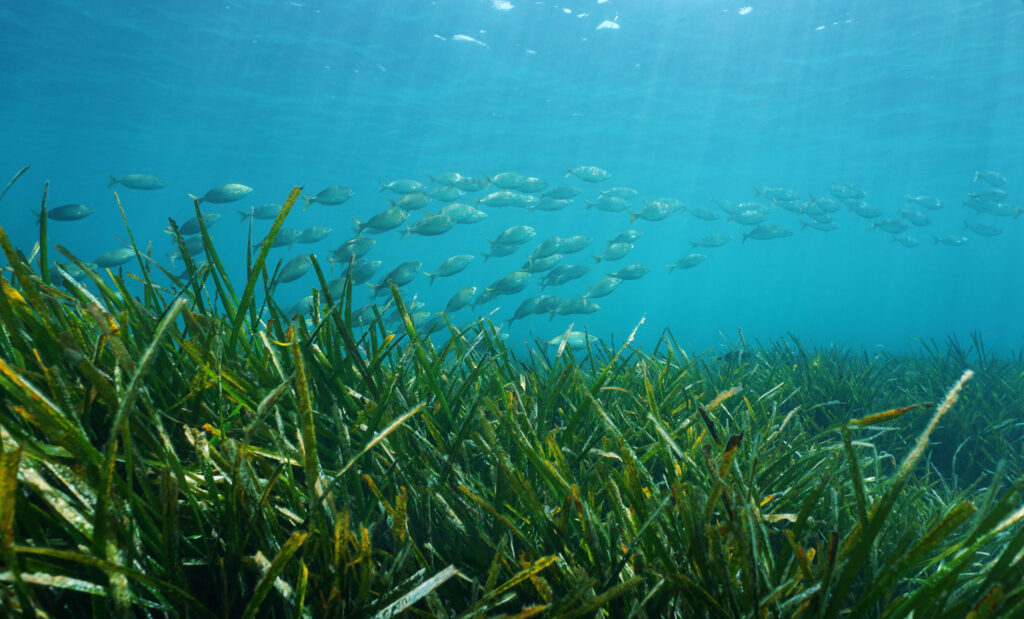In the 1930’s a plant disease and several hurricanes decimated the once abundant eelgrass along Virginia’s coast. This had a direct, negative impact on the clams, crabs and bay scallops that inhabited the area. In 1947, sportsman and publisher Eugene V. Connett wrote about the loss and raised awareness about the loss of the fish who also inhabited the area as well.
While the seagrasses would have naturally recovered from this, unfortunately the development, nutrient runoff and other human impacts during the 1930s while developing the area damaged the marshes, mangroves and remaining seagrasses to the point to where the seagrasses did not recover.
In the late 90s, two local residents named Robert “JJ” Orth and Karen McGlathery – who also just so happened to be longtime students of seagrasses – noticed something promising: small patches of eelgrass in the shallow waters off of Virginia’s eastern shore. For a long time the belief was that the area was inhospitable for the seagrasses from the 1930s events. However, studies showed that the water quality in these coastal bays had recovered.

So what was the issue exactly? Well, seeds from healthy seagrass populations elsewhere along the Atlantic coast simply weren’t reaching these isolated bays. Seagrasses are underwater flowering plants, so seeds are among the main ways they reproduce and spread to new environments. This was great news!
And so in 1999 Orth and McGlathery collected eelgrass seeds by hand from underwater meadows in nearby Chesapeake Bay. They brought the seeds back to their laboratory and stored them in large outdoor seawater tanks until they released their seeds naturally. After about 10 years of gathering the grasses using a custom-built underwater lawn mower, they were able to collect enough shoots so that they could replant them on a large scale in the now baron lagoons.
In 2001 the first round of seeds were tossed from a boat. The first test plots covered 28 acres of mud flats in waters 2 to 3 feet deep. The following year, they observed new seedlings sprouting up from the substrate.
Every year since then, the Virginia Institute of Marine Science and the Nature Conservancy’s Virginia Coast Reserve, along with staff and students from the University of Virginia, have led a team of scientists and citizens to collect and seed a combined 536 acres of bare bottom in several coastal bays. These initial plots took off and rapidly expanded. By 2020 they covered 9,600 acres across four bays.
So why is this such a win? Well, the answer is 2 fold:
1.) because seagrasses host a number of species that both help to keep the lagoon’s water quality clean as well as provide a food source for commercially and recreationally important species of fish.
2.) Coastal systems like lagoons capture and store “blue carbon” or act as carbon sinks. So what does it mean exactly? Well, it turns out that seagrasses play a key role in reducing carbon dioxide in the atmosphere. So these areas where seagrass is abundant are called carbon sinks since they absorb a large amount of carbon dioxide.
It is reported that within only a few years of restoring the seagrass beds, fish and invertebrates returned to the area and established extensive food webs which both brought back the fisheries as well as cleaned the water in the area – since the ecosystem had been restored.
Even more good news: The United Nations has designated 2021-2030 as the U.N. Decade on Ecosystem Restoration due to the success of this project. So we could see the world’s seagrasses restored by 2030 and as a result, a massive reduction in the amount of excess carbon dioxide in the atmosphere.
Amazing!
Read about more conservation wins here: Conservation Wins.
